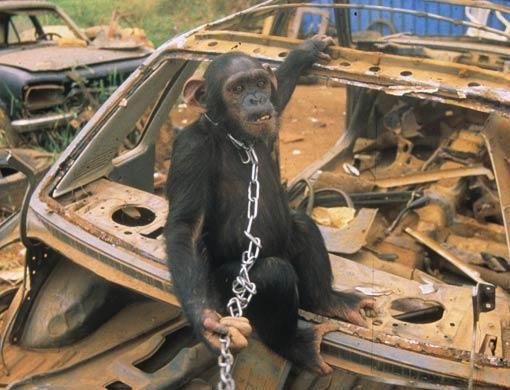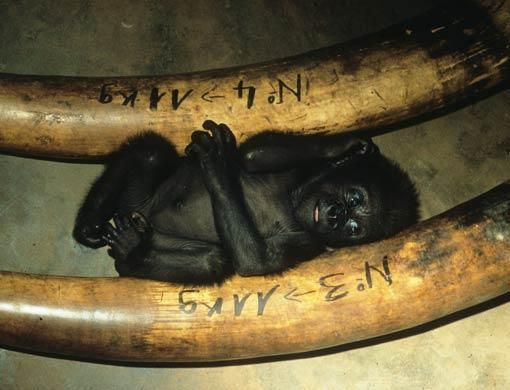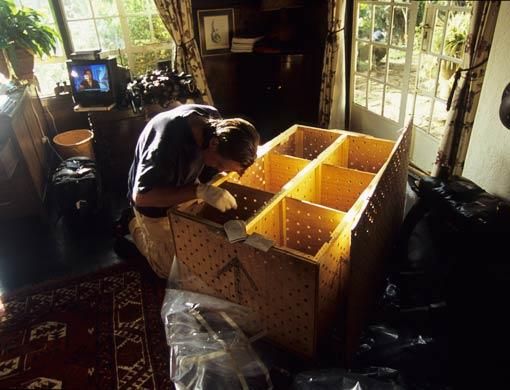Regardless of stiff international regulations, a chimpanzee cartel thrives on the back of demand from private zoos and leading hotels.
It all started in January last year. A crate of five chimpanzees arrived in Kenya's Sweetwaters Chimpanzee Sanctuary after it was confiscated at Nairobi airport. The crate originally carried six chimpanzees - out of which one died - and four monkeys.
Jason Mier, who is a chimpanzee activist, was concerned that such a large shipment of primates was even put together and, he then commenced, what he describes as, an alarming investigation.
The crate, which weighed 64 kg began its air travel from Kano in Nigeria and was heading to Cairo via Khartoum.
However, on arrival in the Egyptian capital, it was refused entry and ordered to return to Lagos on a flight via Nairobi, where it was finally confiscated and directed to the sanctuary in Kenya.
"It was pretty shocking to see the chimps, as the babies arrived packed in this crate and were all stressed and dehydrated without food or water for days. We've also heard that there were two gorillas in the crate but don't know that for sure and have no idea what happened to them," he told Weekend Review when he stopped over for a few hours in Dubai recently.
Fast disappearing
The concern emanates from the fact that chimpanzees and gorillas are endangered species according to the Convention on International Trade in Endangered Species (CITES) and that their illegal smuggling is resulting in the rapid depletion of the primates in their countries of origin.
If, at the start of the last century, there were up to 1.5 million chimpanzees in the African wild, Mier estimates there are a maximum of 200,000 left now. "They've been completely wiped out in four West African countries," he says.
Mier, who is 27, moved from the US to dedicate his life to working with primates. He gets extremely agitated at the threat that man is posing to, what he calls, the great apes of Africa.
With demand for bush meat increasing, chimpanzee and gorilla meat, he says, is highly sought after and many primates are killed mercilessly in Cameroon. "It is the surviving orphaned babies of these animals that find their way into countries in the Middle East," Mier says. "Not only is this scary from the wildlife point of view, but by consuming bush meat, there is an increasing risk of introducing new and different strains of disease into the human population."
Along with associate Karl Ammann, Mier plunged into the investigation that unravelled details of what the "Cairo Connection" was, the results of which has been made into a 27-minute documentary titled Ape Smuggling - The Cairo Connection. "We found that the crate was not listed on the cargo manifest or the passenger manifest, but was travelling with an Egyptian passport holder, Ahmad Ebrahim Abdul Shafy. Also, on that flight, the only other person travelling the same Kano-Khartoum-Cairo route was an Egyptian lady, Heba Abdul Moty Ahmad Saad, who is widely known as a wildlife smuggler," he recalls.
On its return flight to Lagos, via Nairobi, on a Kenya Airways flight, the cargo was listed as accompanying baggage - and not animals, as is required by procedure - under a different passenger's name who, as it turned out, was Heba's daughter. The crate was subsequently confiscated in Nairobi after a Kenyan government vet took the decision to do so because there were no documents from the airline and no address, name or markings on the crate.
Airlines' apathy
Mier and Ammann suspected that the crate they had been exposed to was a freak incident of bad timing for the smugglers and that there must have been many more attempts that were probably successful. As they dug around for more information, the two discovered that there had been numerous shipments of undocumented wildlife, many warning letters from the Cairo Airport Authority and that Kenya Airways had been a prime carrier of the animals, shipping out undocumented for wildlife in inappropriate containers.
"What really bothered us was that such shipments could be accepted and handled by international airlines, which can actually play a huge role in preventing illegal wildlife trade. We have all the evidences of these trips and the various correspondences with the airline, including the letters of denial from their side despite our writing to them supplementing it with our findings," Mier says, showing scanned copies of the proof on a compact disk.
The next logical step for them was to visit Cairo to find out what was prompting the heightened activity in chimp smuggling. Funding for this fact-finding exercise has rarely come from outside as it often comes with conditionalities.
"We can't name and shame certain organisations as they are patrons of the donor foundation," Mier says. Using their own finances and risking the use of a hidden camera to validate their documentary, Mier and Ammann concluded that it stemmed from a growing trend of displaying exotic fauna. Private zoos or roadside zoos were not uncommon and were even openly advertised by leading hotels on their websites, who were unafraid of flouting CITES regulations.
On their trips, they found and saw 26 chimpanzees and four gorillas and Mier says he won't be surprised if there are more. Thanks to CITES, Mier explains that it's now possible to trace the source of the trade as all endangered species are required to have trade records.
"But the primates in Egypt have no track-back papers. In the resort of Sharm Al Shaikh, there are two chimpanzees locked up in a private zoo, with a baby that's not even a year old, alone in a dark cave. These are animals that are used to playing freely out in the wild and are now reduced to living in appalling conditions," he says, running me through photographs of the chimps.
"This is the place that Tony Blair visits and stays in," he adds.
However, their investigation was not without trouble as they were asked to leave the hotel when the culprits caught a whiff of what the two men were trying to unearth.
"There was another private zoo that hides a collection of apes - 11 chimps and two gorillas, of which, one has a CITES permit. "To smuggle a gorilla, the owner writes for a permit. Papers are issued only in Arabic, which goes against CITES regulations that require papers to be issued or accompanied by copies in English, Spanish or French."
Convinced of a strong Cairo link, Mier and Ammann searched for further documentary evidence and found more flight manifests that revealed more shipments to Cairo and other parts of the Middle East. It also emerged that Heba and her daughters are key players in trading illegal wildlife, going back as far as 27 years.
"Bribing Nigerian officials for export documents that describe them as monkeys and not as chimps or gorillas makes things easier and it helps that Heba's husband runs a transport business with offices in Nigeria, Cameroon and Cairo," he says.
To complete their investigation, Mier headed out to Kano and spoke to a couple of dealers including the doorman at Heba's house, who, Mier says, offered to sell him a chimp for $350, as opposed to another offer of sale in Cairo for $5,000. He adds that if one were to go straight to the source in the Cameroon village, a chimpanzee can be bought for as less as $50.
Mier says that Heba is now well settled in Cairo. Her neighbours in Nigeria and most people are aware of her dealings. On investigating the whereabouts and details of the man, Abdul Shafy, who was transporting the crate of six chimps, Mier found that Heba and her daughters were linked to Shafy, who is a paediatrician. "Many of the CITES and quarantine officials told us that he uses chimps for tissue and organ transplants," he reveals.
Having worked with chimpanzees in close proximity, Mier says that they are fun to interact with and are interesting animals. But he is dead against the idea of using them as fashion statements. "I don't have a problem if, for instance, a confiscated chimpanzee is cared for in an approved sanctuary. But it becomes a problem when primates are hunted purely to satisfy someone's need for entertainment," he says.
Toothless organisation
In the entire process, CITES, he believes, has come out as a rather toothless organisation that is not in a position to enforce its regulations even in countries that have signed up.
"They just told us that it's up to the signatory countries. Now, that's going to require a great deal of political will and how willing are governments in Cameroon, Nigeria, Egypt and Kenya going to be?" he asks.
With the documentary close to completion at the time of the interview, Mier is on the urgent lookout to get it beamed to as many viewers possible.
"Sensitising viewers on the one hand, but more importantly, to initiate some serious action against open violators of wildlife acts and efforts."
"It's not personal," he says of the documentary that focuses on a couple of names and organisations. "It just so happens that it's one case study that was investigated further to reveal quite a bit. I'm sure there are other flouters and smugglers. As an animal lover and activist, I'd like to see all illegal trade of wildlife stopped. That's all."
The role CITES plays
The Convention on International Trade in Endangered Species of Wild Fauna and Flora (CITES) is a global agreement between member states and aims to make sure that international trade of animal and plant life does not threaten their existence.
As cross border trade of wildlife involves different countries an arrangement between countries was required to facilitate international cooperation to protect over-exploitation. The CITES website states that it offers varying degrees of protection to more than 30,000 species of animals and plants, whether they are traded as live specimens, fur coats or dried herbs.
Enforced in 1975, CITES is not a substitute for national laws. It is legally binding on the signatory parties, however, is primarily a framework within which countries have to adopt and enforce their own national regulations to make it successful in its mission.
It now has 169 countries that have signed up as CITES parties.
Smuggling continues
Follow-up trip reveals no change in situation
Following his meeting with Weekend Review, Jason Mier undertook a follow-up trip to Egypt to investigate if the situation had improved. "Far from it," he told us after returning to his base in Kenya. "While I would be happy to say nothing has changed meaning there is no more smuggling and the appearance of new animals has stopped, I must instead say nothing has changed in the fact that on every single trip - including this one - there are more and more chimpanzees and other animals on display and offered for sale," he says.
Mier has written to the CITES Secretariat informing them specifically of his observations. On an earlier trip last November to the Hauza Hotel in Sharm Al Shaikh, he found that the owner Ashraf Enab had two chimpanzees, with some of the employees stating he had more at home. The hotel's website was later updated with pictures of a new chimpanzee. "Hotel travel reports on other websites indicated that he had young chimpanzees which were now available as photographic props," he says in his letter to CITES. "These are kept in three separate groups, the two oldest chimpanzees together, then one individual kept by himself in a completely closed room with no sunlight. They are kept in human baby clothing, and for 5 euros any visitor can have a picture taken with them."
Mier met with Dr Talaat Sedrak, the CITES representative in Egypt, and informed him of the findings. Mier says that according to Dr Sedrak, the Egyptian CITES authorities have given no permission to anyone or any facility to hold any apes other than the Giza zoo, the Alexandria zoo and to Gamal Omar/Tower Hotel to house until a suitable facility can be found - not own - only eight chimpanzees and one gorilla.
"He [Dr Sedrak] asked why Gamal Omar's facility could not be a sanctuary and all apes sent there. I stated that as I felt that Gamal Omar and his son were smugglers, and with the extremely bad conditions and secrecy in which the animals are kept, it would be inappropriate for this to be considered a sanctuary. He ‘corrected' me in saying that Gamal Omar does not actually bring the animals into the country, but instead only buys them from the people which smuggle them in. He did not seem to appreciate my reasoning that if he is allowed to buy up smuggled apes that he is creating the problem, not solving it," Mier tells us and writes to the CITES officials. "He also mentioned that he was well aware of Heba and her involvement in smuggling but there was nothing he could do."
When Mier asked Dr Sadrek about when he would take action against Heba and her family and Dr Abdel Shafy, the CITES official said that there was nothing he could do as they were powerful people. On Mier's suggestion that Dr Sadrek should resign in protest and explain to the CITES Secretariat why he quit, the Egyptian representative requested that Mier write a report to them asking the Secretariat to tell him what his responsibilities are under CITES.







